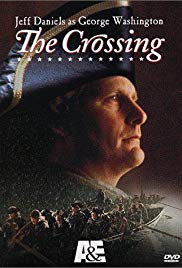THE CROSSING
SUBJECTS — U.S./1750-1812; New Jersey & Pennsylvania;
SOCIAL-EMOTIONAL LEARNING — Courage in War; Leadership;
MORAL-ETHICAL EMPHASIS — Trustworthiness; Responsibility; Citizenship.
AGE; 13+; No MPAA Rating;
Drama; 2000; 135 minutes; Color.
THE BEST OF TWM
One of the Best! This movie is on TWM’s short list of the best movies to supplement classes in United States History, High School Level.
MENU
MOVIE WORKSHEETS & STUDENT HANDOUTS
TWM offers the following movie worksheets to keep students’ minds on the film and to focus their attention on the lessons to be learned from the movie.
Film Study Worksheet for a Work of Historical Fiction; and
Worksheet for Cinematic and Theatrical Elements and Their Effects.
Teachers can modify the movie worksheets to fit the needs of each class. See also TWM’s Historical Fiction in Film Cross-Curricular Homework Project and Movies as Literature Homework Project.
Teachers can modify the movie worksheets to fit the needs of each class. See also TWM’s guide to Lesson Plans Using Film Adaptations of Novels, Short Stories or Plays.
DESCRIPTION
This film is a dramatization of Washington’s victory at Trenton the day after Christmas, 1776. Had Washington not attempted the crossing of the ice-choked Delaware River and had the ill-fed, freezing, poorly trained, and poorly armed Continentals failed to prevail over the feared Hessian mercenaries, the American Revolution would probably have collapsed. This movie presents an account of that battle.
SELECTED AWARDS & CAST
Selected Awards:
2001 Peabody Award; 2001 American Society of Cinematographers: Outstanding Achievement in Cinematography in Movies of the Week/Mini-Series/Pilot for Cable or Pay TV; 2001 Emmy Award Nominations: Best Editing.
Featured Actors:
Jeff Daniels as General George Washington, Roger Rees as General Hugh Mercer, Sebastian Roche as Colonel John Glover, Steven McCarthy as Alexander Hamilton, John Henry Canavan as General Henry Knox, Ned Vukovic as General William “Lord” Stirling, David Ferry as General Nathaniel Greene, Nigel Bennett as General Horatio Gates, Karl Pruner as General John Sullivan.
Director:
Robert Harmon.
BENEFITS OF THE MOVIE
The film shows a key event in the Revolutionary War and gives students a glimpse of one of those extraordinary battles in which a few determined soldiers changed the course of history. It shows some of the difficulties in a revolution against the powerful forces of the British Empire. The movie humanizes George Washington, often seen as distant and aloof, as he contends with vastly superior British forces.
Students will understand the desperate situation of the Continental Army and of the Revolution in December 1776 and the pivotal role of the Battle of Trenton in saving the Revolution. The film provides opportunities for students to exercise reading, research, thinking, and writing skills.
POSSIBLE PROBLEMS
Several: Substantial historical inaccuracies are described in the Helpful Background Section in the Supplemental Materials. On the whole, however, the movie conveys an accurate picture of the plight of the Continental Army in December of 1776 and the difficulties faced by George Washington in leading the army. There is a moderate amount of blood and violence in the war scenes and a substantial amount of profanity throughout the film.
PARENTING POINTS
Before watching the film, tell your children about the importance of the Battle of Trenton.
HELPFUL BACKGROUND
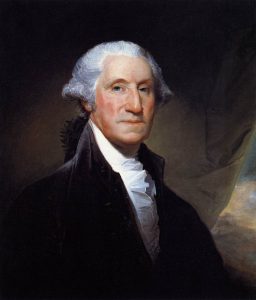
Portrait of George Washington, 1795
by Gilbert Stuart, Metropolitan Museum of Art, New York
Washington wrote the following letter describing the victory to General Alexander McDougall who had fought alongside him at White Plains and Germantown.
Gen McDougall/ Head Quarters, Newtown 28th December 1776: I have yours of the 27th and am sorry that Affairs bore so bad an Aspect in your Quarter at that time. But I hope that the late Success at Trenton on the 26th and the Consequence of it, will change the face of Matters not only there but everywhere else. I crossed over to Jersey the Evening of the 25th about 9 miles above Trenton with upwards of 2000 Men and attacked three Regiments of Hessians consisting of fifteen hundred Men about 8 o’clock next Morning. Our Men pushed on with such Rapidity that they soon carried four pieces of Cannon out of Six, Surrounded the Enemy and obliged 30 Officers and 886 privates to lay down their Arms without firing a Shot. Our Loss was only two Officers and two or three privates wounded. The Enemy had between 20 and 30 killed. We should have made the whole of them prisoners, could Genl. Ewing have passed the Delaware at Trenton and got in their Rear, but the ice prevented him. I hope you, Sir,– and every Gentleman who is well affected will exert themselves in encouraging the Militia and assuring them that nothing is wanting, but for them to lend a hand, and driving the Enemy from the whole province of Jersey. Pray watch the motions of the Enemy, and if they incline to retreat or advance, harass their Rear and Flanks But at all Events endeavor to collect a Body of men to be ready to join me, or act otherwise as occasion may be.
A Note on The Character of George Washington
The tremendous good fortune of the United States in the character of its Founding Fathers is exemplified by George Washington. Volumes have been written about his character. Here are a few points that have impressed us:
The man had perhaps the best judgment of any figure in history. He had the capacity to take a situation and make the correct decision that would inspire generations. There are many examples, but the foremost is his decision to retire from public life at the height of his power and prestige as Commander in Chief at the end of the Revolutionary War. This was, perhaps, one of the first times that a leader had voluntarily retired at the peak of his power. Washington performed the same feat again, when he retired from the Presidency after two terms in office.
In 1776, historian David McCullough notes that although Washington was “[A]s subject as any man to moments of doubt and uncertainty, he managed to summon the self-confidence necessary to persevere amid disaster. He was … resilient, open to new ideas and seldom failed to learn from his mistakes….”
There is one area in which Washington is to be criticized: as one of the richest men in Virginia, he held slaves. Washington lived in a society in which holding slaves was not considered immoral. However, here again, Washington proved himself more discerning than his peers. In his will he freed his slaves and created a trust fund to help them adjust to freedom.
Humanizing an Icon
George Washington was a man tortured by fears of failure in his role as Commander in Chief. He had three passions in life: the Revolution, architecture, and the theatre. He personally directed large additions to his home at Mount Vernon and when public duty called him away, Washington wrote detailed instructions to his managers about the project. As for the theatre, he would, if he could, go to plays four nights a week. Washington also loved to dance.
When he was growing up, Washington’s family didn’t have the money to send him to school and he received little formal education. He married into wealth. By middle age, Washington had lost most of his upper teeth. He tried several kinds of dentures, some of which were very painful.
Washington’s Leadership At the Battle of Trenton
General Washington displayed many of the attributes of good leadership in the Battle of Trenton and some of these are shown in the film. They are: (1) He understood the larger picture and that the Revolution needed a victory. No one on the British side appreciated this fact. If they had the Hessian troops would have been on alert and Colonel Rall would have reacted to the message that the colonists were marching on his position. (2) Washington seized the initiative so that he had some control over events.(3) He selected good subordinates to carry out his orders such as Knox and Glover. (4) He knew when to stand steadfast (for example his determination to press on with the attack in the face of the blizzard and even though it could not be started before dawn). (5) Washington knew how to inspire his men. (6) Washington accurately forecast the actions of his adversaries.
Notes on Men Featured in the Film
Alexander Hamilton: Although “The Crossing” has a young Alexander Hamilton acting as Washington’s aide, he did not come into that position until several weeks after the Battle of Trenton. It was a young Lieutenant James Monroe (the future president) and Washington’s distant cousin, Captain William Washington, who attacked the Hessian outpost, rather than Hamilton. They were both wounded in that action. However, the film is right about the close relationship between Washington and Alexander Hamilton, with Washington taking a paternal role.
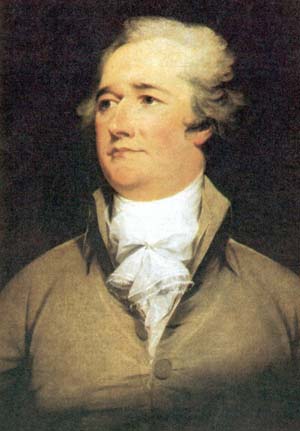
Portrait of Alexander Hamilton
by John Trumbull (1792)
National Gallery of Art
Alexander Hamilton is an example of the promotion by merit in the Continental Army and later in the new nation. Hamilton had been born illegitimate in the West Indies. Despite this humble background, he became Washington’s personal secretary and aide after the Battle of Princeton. Hamilton was a co-author, along with James Madison and John Jay of the Federalist Papers. Later, Washington would appoint him to be the first Secretary of the Treasury. Ironically, both Hamilton and the man who would later shoot him to death in the famous duel, Aaron Burr, participated in the Battle of Trenton.
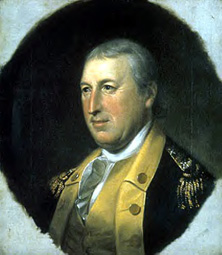
Horatio Gates
Horatio Gates: Gates has a bad reputation with Washington admirers because he repeatedly schemed to become head of the Continental Army. Gates had more military experience than Washington and considered himself the superior soldier. Many agreed with this assessment after the long and disastrous retreat from New York City. Gates considered Washington a “damned poor leader.” The film is accurate in its depiction of Gates’ contempt for the Virginian and Gates’ unwillingness to let his superior know the movements of his army. Howard Fast, the author of the screenplay, suggested that Gates might have made the argument that: 1) Washington’s “soldiers” were untrained and undisciplined; 2) they had only retreated and did not know how to attack; 3) their enlistments would be up in 11 days and they had no incentive to take any risks; 4) it would be impossible to keep the attack secret from the Hessians; and 5) the Continentals could not defeat the Hessians, the most rigorously trained professional soldiers Europe had to offer. Actually, Washington and Gates met alone that night. When Washington understood that Gates’ presence would only undermine troop morale, he ordered the general out of camp or let him run to Congress to complain of ill-treatment. What we do know is that Gates left Washington’s camp without his army and was scheming with various Congressmen to become commander of the Continental Army even as Washington made his desperate gamble at Trenton.
Gates was still intriguing to supplant Washington in 1778 when he conspired with a clique known as the “Conway Cabal”. Washington fended off the effort by exposing Gates’ lies. Gates’ downfall occurred in 1780 when he lost a battle at Camden, South Carolina, to Lord Cornwallis and was suspended from duty. The film captures Gates’ arrogance but ignores his better qualities such as his extreme generosity to indigent and wounded soldiers and the decision to free his slaves before leaving Virginia to live in New York City.
For a website about General Gates, see Famous Americans

John Glover: Glover was from Marblehead Massachusetts. Born into humble origins, he saved his money to buy a schooner. By the time of the Revolution, he was a wealthy man and colonel of the local militia, a group he took with him into the fighting. Three of Glover’s own ships were the first vessels in the American Navy, and Glover’s resourcefulness was indispensable to the American cause. Glover and his fishermen saved the Continental army three times during the long retreat to the Delaware River. Perhaps the most spectacular extraction was on August 29, 1776, four months before the Battle of Trenton, when Washington’s army was trapped on Long Island. In a move that would win him the nickname “the Old Fox”, Washington ordered Glover’s sailing soldiers to take his army across the mile-wide East River in the face of a body of troops three times its size. The “Marvelous Men of Marblehead” moved 9,000 troops and their equipment to safety, and the Continental Army lived to fight another day. The English historian George Trevelyan said of these “web-footed soldiers”: “It may be doubted whether so small a number of men were ever employed in so short a period of time with greater and more lasting results.” The modern Marines claim Glover’s Marblehead men as the first of the “old Corps”.
“The Crossing” makes Washington’s confidence in Glover explicit, as he puts the scrappy sailor in charge of everyone, even himself, when on the river. Over Glover’s protestations, he was promoted to brigadier general two months after the Delaware crossing. The film shows Washington complaining that Glover has been “a thorn in my side since the day we met”. In fact, two men more different than the Virginia aristocrat with Deist tendencies and “the Marblehead fisherman of the Congregational persuasion” would be difficult to imagine. The only thing they seemed to share was an aversion to wigs. Though Washington powdered his hair, he wore his own. To learn more about how the “Headers” are still remembered in Marblehead, Massachusetts, read “The Ebbing Tide is Reversed” from the Marblehead Magazine.
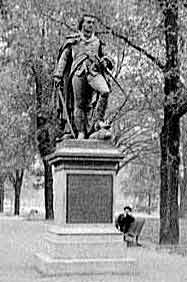
Glover Statue, Marblehead, Massachusetts
For websites about Glover see Article on John Glover in Wikipedia. The best biography of Glover is by Nathan Billias, John Glover and His Marblehead Mariners, published in 1960.
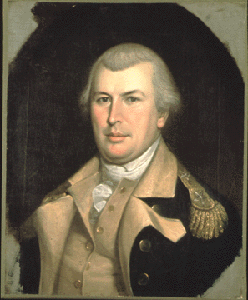
Nathanael Greene: Raised a Quaker in Rhode Island, Greene was read out of his Meeting House when he violated his church’s “peace testimony” and joined the Continental Army. Greene and Washington were the only Continental generals to serve through the entire Revolution. At Trenton, Washington expressed his confidence in Greene by giving him command of half the army. After distinguishing himself during battles in New Jersey and Pennsylvania, Greene was made commander of the Southern Department. There he showed himself to be one of the best strategists in the army.
Because Greene donated all of his possessions and property to aid the Revolution, the state of Georgia awarded him a plantation near Savannah. Greene died there only three years after peace came.
For a website about Nathanael Green see Major General Nathanael Greene from wikipedia.org.
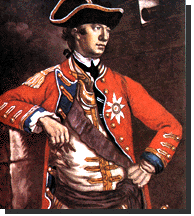
William Howe: Military historians still debate the virtues and flaws of Howe as British commander in chief. Howe succeeded Thomas Gage in 1775 and led successful assaults against Washington’s army in New York. However, he allowed the Continental Army to escape from Long Island, and lost an opportunity to put an early end to the rebellion. Because of his affair with Elizabeth Loring, the wife of Loyalist Joshua Loring, he lingered in Philadelphia during December, 1776. As the character of Hugh Mercer suggests to Washington, the fetching adulteress may be credited with the “continuing existence” of the American army. Howe was mortified by the defeats at Trenton and Princeton, but did not seem to learn the lesson of speed and flexibility. During the Battle of Saratoga in 1777, he again remained in Philadelphia instead of joining General Burgoyne. The Continentals victory at Saratoga achieved an alliance with the French that would turn the tide of Revolution. Howe was removed from command in 1778 and Sir Henry Clinton became commander in chief.
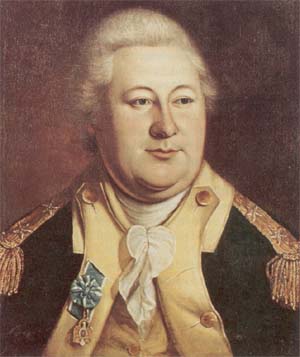
Henry Knox
Henry Knox: Knox would serve as Secretary of War during the two terms that Washington served as president and into the Adams presidency. Knox had first come to Washington’s attention during the siege of Boston when he suggested that the lack of artillery could be overcome by fetching guns from forts near the Canadian border. By extraordinary efforts, Knox loaded 42 sleds with cannon, howitzers, and guns and brought them to the American lines in December. Knox was made into a brigadier general and became Washington’s friend and counselor throughout the rest of his life.
The film has Washington making an off-color remark about Knox’s weight while getting in the boat, and Howard Fast, the screenwriter, got this information from soldiers’ accounts written long after the battle. What Fast claims Washington said, “more or less” was: “Shift your fat ass, Harry, but don’t swamp the **** boat!” Fast believes that the general’s “gutter language” helped break the tension and save the day. See sidebar. However, four months before the battle, Washington had issued an order to his officers to check the “foolish, and wicked practice, of profane cursing and swearing,” reasoning that “we can have little hopes of the blessing of Heaven on our Arms, if we insult it by our impiety, and folly.”
Whether or not Washington made a crude comment on Knox’s hefty weight that night, it is true that Knox was fat, and managed to maintain much of his weight even through the experience at Valley Forge. However, his usefulness in the Battle of Trenton is undeniable, not only because he was able to bring all of his artillery over the river and back, but also because he stood on the shore for hours, calling out in a deep bass voice to lead the boats across to the proper landing site. Knox had been a bookseller in Boston at the outbreak of the war. He is another example of men who rose in the Continental Army by virtue of merit rather than birth.
For websites on Henry Knox, see Famous Americans and Who Served Here? General Henry Knox.
SIDE NOTE:
The screenwriter, novelist Howard Fast, wrote that on this occasion:
More than a dozen people, present or close, wrote down what he – the writer – felt were the general’s exact words, but these historical entries took place months or years later. The general, in an age noted for forthright language, had a most extraordinary command of gutter language; and whatever the exact words at the moment, it broke up the men on the dock. Half-hysterical already, their laughter was contagious. “What did he say? What did he say?” went down the line of waiting men. The story grew in the telling, and the men, wet, miserable, dispirited, became hysterical with laughter.
A few hours later, as dawn was breaking, two thousand half-naked, bearded, screaming kids, with no shot fired – a flintlock musket is useless in the rain – poured into Trenton and captured the entire Hessian garrison without losing a man; and once again, the United States of America became a possibility. Did Washington’s Wisecrack Tip the Balance by Howard Fast, “Americana” December, 1992, p. 6+.
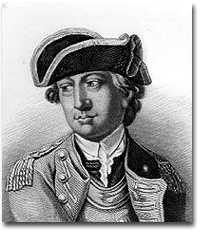
Charles Lee
Charles Lee: General Lee held George Washington in low regard, remarking to Gates that he was “damnably deficient” as a leader. Both Gates and Lee were insubordinate to Washington, and after Fort Washington fell in New York, Lee refused to cross the Hudson to help. One historian suggested that Lee “seems deliberately to have left Washington to face complete disaster and thus prove his incompetence; then, as the undefeated general, he could take chief command.” (George M. Wrong, “George Washington and His Comrades in Arms“.)
As the film shows, Lee was planning to ignore Washington’s orders to come to Delaware, but fate intervened. The arrogant commander fell into a British trap. Captured in bed, General Lee was “obliged to bestride a horse in nightgown and slippers.” While spending sixteen months in British custody, Lee apparently tried to interest the British in his plan to force the Americans to surrender, an act that would be viewed as treason when it became known after the war. Lee was released and once again placed in command at the Battle of Monmouth. George Washington had a volcanic temper and kept it under close control. However, when he saw Lee leading his troops in retreat at Monmouth, he screamed and cursed at him before relieving him of command.
Washington had at last had enough of Lee, and had him court-martialed and dismissed from the army for disobedience and insubordination. “The Crossing” refers to Lee indirectly, as Washington wonders where his army was. Happily, when Lee was captured by the British, his army was marched by General Sullivan to Delaware and put under Washington’s control. “The Crossing” gives the correct impression that Washington faced not only British and Hessian enemies but also his own generals who frustrated and ignored him. The Battle of Trenton and the Battle of Princeton less than a week later, at last, gave George Washington the authority to truly command his own commanders.
For a website on Charles Lee, see Charles Lee from wikipedia.org
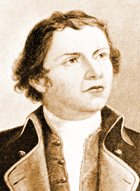
Hugh Mercer
Hugh Mercer: Mercer had the most romantic past of Washington’s immediate companions during the crossing of the Delaware. Born in Scotland, Mercer had been a doctor in the army of “Bonnie Prince Charlie”, the Stuart trying to reclaim the throne his grandfather lost. After the defeat of the “Pretender”, Mercer decided to try his luck in the New World. Like Washington, Mercer was with General Braddock at the horrific defeat in 1755 during the French and Indian War. At thirty-five, he left the military and became a doctor in Washington’s hometown of Fredericksburg, Virginia. One of his patients was Mary Washington, mother of George Washington. Mercer joined the revolution in 1775 and served at Washington’s side. He was one of the few Continental casualties in the Battle of Princeton. Surrounded, Mercer refused to surrender and was bayoneted a dozen times. He died of his wounds two weeks later. The circumstances of his death made him a martyr to the cause of American independence. Counties are named in his honor in New Jersey, Pennsylvania, West Virginia, Kentucky, and Illinois.
For a website on Hugh Mercer, see Hugh Mercer from HistoryPoint.org.
Colonel Johann Rall (sometimes written Rahl): This Hessian mercenary officer proved a boon to the Continentals and a disaster to the troops he commanded. Though he had been warned that “the Old Fox”, as Washington had been nicknamed because of his cunning escapes in the face of defeat, was capable of speed and daring, Rall neglected to reinforce the area around Trenton against attack.
When he was urged to name a place for the evacuation of baggage in case the Continentals attacked, he scoffed: “Fiddlesticks! These clod-hoppers will not attack us, and should they do so, we will simply fall on them and rout them!” If the Americans cross the river, “Let them come! We want no trenches! We’ll use the bayonet!” The Hessians were fighting for pay, not loyalty or idealism, and they had plundered the citizens of New York, Pennsylvania, and New Jersey so thoroughly that even Loyalists detested them. In Trenton, when the Continentals attacked, some citizens grabbed their firearms and joined in the fight against the occupiers who had burned their furniture rather than exert themselves to chop wood. Colonel Rall, killed in action at the Battle of Trenton, paid for his arrogance with his life.
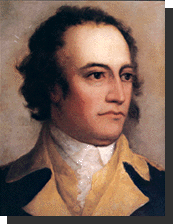
John Sullivan
John Sullivan: served as a representative from New Hampshire at the Second Continental Congress and had been with Washington during the siege of Boston. After a desperately fought campaign in Canada, and the rout of the Continental Army in New York, Sullivan was captured by the British and exchanged just in time to fight in the Battle of Trenton. George Washington put him in charge of half the army crossing at McConkey’s Tavern. The film is correct in that when Sullivan sent word to Washington that the muskets would not fire because of damp and sleet, Washington ordered: “Tell General Sullivan to use the bayonet. I am resolved to take Trenton.”
Sullivan acted bravely that day and in the Battle of Princeton that followed. However, like Gates and Lee, Sullivan went over Washington’s head to complain to Congress that he was not getting him the proper promotions. In 1777, Washington wrote: “No other officer of rank in the whole army has so often conceived himself neglected, slighted and ill-treated as you have done, and none I am sure has had less cause than yourself to entertain such ideas.” After a string of defeats, Sullivan left the army and returned to New Hampshire, becoming first a Congressman and then governor of the state.
FACTUAL INACCURACIES
There are a substantial number of historical inaccuracies in the film, however, the main points and general impression conveyed by the film is accurate. The largest error is that it underplays the severity of the weather. Washington and the Continentals crossed the river, marched 9 miles to Trenton and attacked the Hessians in a true blizzard. The only American deaths occurred when two soldiers froze to death. The decision to cross back over Delaware was not only due to fear of the British but the American soldiers had broken into hogsheads of rum and were getting drunk. Washington feared he would lose control of his men. Before the attack on Trenton, Washington divided his army into three parts. Washington kept command of roughly one-third of the army. The other two parts, led by Generals Ewell and Cadwalader, were to cross the river from different landing sites. Lacking the Marbleheaders, they didn’t make it to the other side in time to join in the battle.
In the movie, Washington is told that no Continentals were killed and none wounded in the battle. It is correct that there were no deaths in the battle itself (two soldiers froze to death on the march to Trenton), but a few officers and soldiers were wounded. Hamilton did not become Washington’s secretary until later in the war. He did not participate in the attack on the Hessian outpost. However, the close relationship between Washington and Hamilton, with Washington taking a paternal role, is accurate. The screenwriter departed from the historical record to show this relationship. Washington’s interview with General Gates was private, not at dinner with Washington’s staff in attendance. No one knows what was said in the interview. The screenwriter used the dinner scene to show Gates’ contempt for Washington and to present the arguments against the attack.
Perhaps the most objectionable historical inaccuracy is Nathaniel Greene’s statement to Washington that the American colonists were fighting primarily for economic reasons. After the battle, General Greene asks General Washington to speak with Colonel Rall before Rall dies. This request sets up the following exchange: Washington: “Do you want me to weep for those bastards, men who kill for profit?” Greene: “Our own cause at its heart is a fight against taxation is it not? In the end, we all kill for profit, the British and the Hessians and us.” This is an inaccurate and cynical view of the American Revolution. The rallying cry of the revolution was “No taxation without representation.” The tea tax, for example, that sparked the Boston Tea Party was a very small tax. The noble and revolutionary sentiments that ” … all men are created equal, that they are endowed by their Creator with certain unalienable Rights, that among these are Life, Liberty and the pursuit of Happiness. That to secure these rights Governments are instituted among Men, deriving their just powers from the consent of the governed….” are not based primarily on a desire for monetary gain.
USING THE MOVIE IN THE CLASSROOM
Enrichment Worksheets are a TWM innovation containing questions designed to get students thinking. Questions are focused on comprehension, application, analysis, syntheses or evaluation. Questions can be answered in class or as homework, as quick writes, journal entries, formal essays, or research papers. For a version of the Worksheet in word processing format, click here.
Pre-Viewing Enrichment Worksheet for The Crossing
During the period between the signing of the Declaration of Independence in July and December 1776, the Continental Army had been repeatedly defeated. The Americans had been routed at Long Island and forced to withdraw from New York City. Two of their most important forts on the Hudson River, Fort Lee, and Fort Washington, had fallen to the British. In a desperate attempt to save the army, Washington retreated to “the Jerseys”, as the area was then called. The British commander, General Howe, settled in for the winter in Philadelphia, enjoying a romantic dalliance with the wife of a prominent Loyalist. He failed to “foreclose the mortgage” on the rebels, as one of his officers later said in disgust.
Since taking command of the Continental Army and forcing the British to retreat from Boston in March of1776, Washington had not had a victory and had lost New York. Deeply discouraged, he wrote to his brother that, “the game is pretty near up.” In November, Washington unsuccessfully attempted to raise the New Jersey militia, and when 2026 men had their term of enlistment expire, they refused to reenlist, even though the British army was only a march away. Almost all of the Continental soldiers were ill-fed and poorly clothed. Many were sick. Everyone felt that the crisis had been reached and that the American army was dissolving in the face of the enemy and the harsh winter. As Colonel Joseph Reed wrote Washington: “Something must be attempted to revive our expiring credit, give our cause some degree of reputation, and prevent a total depreciation of the Continental money.”
Question 1: Before the Battle of Trenton, given the recent defeats of the Continental forces, what type of soldier would have risked his life to cross Delaware and fight to feared Hessians? Explain your answer.
Washington resolved to make one last attempt to prevent the Revolution from being what people were openly calling it: “a noble cause lost.” The main force of the Continental Army, would cross the Delaware River at night. They would surprise a 1400 man contingent of the dreaded Hessian mercenaries who had occupied Trenton. Washington divided the attacking force into three groups. He would lead 2400 men across the Delaware, and Generals Ewell and Cadwalader (1,000 and 2,000 men respectively) would each lead other crossings at different locations. With Washington were Major John Glover’s Marblehead Men, experts in handling boats. They were responsible for ferrying Washington’s troops across the ice-choked river. Ewell and Cadwalader were unable to manage the crossing on time and their soldiers played an active role in the battle. In order to simplify the battle plan, the film does not mention the troops led by Ewel and Cadwalader.
The river crossing began at 3 p.m. on Christmas Day. The weather caused tremendous hardship. Washington’s aide, Colonel John Fitzgerald, wrote at 6 p.m., as the troops started to cross the river: “It is fearfully cold and raw and a snowstorm is setting in. The wind is northeast and beats into the faces of the men. It will be a terrible night for those who have no shoes. Some of them have tied only rags about their feet: others are barefoot, but I have not heard a man complain.” The weather, as challenging as it was, proved an advantage to the Continentals, for it was blowing into the face of the enemy. Also, the severity of the cold convinced the Hessians and the British that the Americans would not attempt a crossing. The normal patrols were cancelled, and the Americans were able to approach undetected.
Washington’s troops did not get across the river until 4 a.m., with the result that the Hessian encampment would have to be attacked in daylight. Observing his commander at that hour, a young fifer named John Greenwood wrote: “I have never seen Washington so determined as he is now. He stands on the bank of the river, wrapped in his cloak, superintending the landing of the troops. He is calm and collected, but very determined. The storm is changing to sleet, and cuts like a knife.”
The Battle of Trenton began at 8 a.m. on December 26th as Hessian sentries opened fire. The Hessians were completely unprepared, though it is a myth that they were expected to be drunk. The Germans celebrated their festivities on Christmas Eve, thus the soldiers would have had a full 36 hours to sober up. The Hessians had been on constant alert for weeks. While the Americans had covered their flintlocks with their cloaks so that their powder would remain dry, the Hessians found most of their guns to be useless. 106 Hessian soldiers were killed or wounded and around 900 were captured. Many escaped. As the film shows, their wounded leader, Colonel Rall, pleaded with Washington for his troops to be treated humanely. Washington agreed, despite the fact that during the Battle of Long Island, the Hessians had slaughtered American soldiers who were attempting to surrender.
The Americans suffered only two fatalities; soldiers who had frozen to death on the march. Two officers and several American soldiers were wounded. (In the movie Washington is told that there were no Continentals killed and none wounded in the battle. It is correct that there were no deaths in the battle itself, but a few officers and soldiers were wounded.) Exuberant Continentals broke into hogsheads full of liquor and began to get drunk as soon as the shooting stopped. This disorderly behavior, along with the fact that the British could attack from Princeton at any moment, made General Washington decide to get his troops back across the river to Pennsylvania. This time they crossed the Delaware with their prisoners, 1,000 weapons, several cannon, and stores of ammunition they had confiscated from the enemy. Glover’s Marblehead Men accomplished the task again. The next day, a thousand Continental soldiers reported ill.
Question 2: Washington’s decision to break up the victory party after the Battle of Trenton and get the Army back across the river, reveals something important about Washington’s abilities as a leader. What does it reveal?
General Washington displayed many of the attributes of good leadership in the Battle of Trenton and some of these are shown in the film. He understood the larger picture and that the Revolution needed a victory. No one on the British side appreciated this fact. If they had, the Hessian troops would have been on alert and Colonel Rall would have reacted to a message he had received that night that the colonists were marching on his position. Furthermore, Washington seized the initiative so that he had some control over events and selected good subordinates to carry out his orders. He knew when to stand steadfast, exemplified by his determination to press on with the attack in the face of the blizzard. Moreover, Washington knew how to inspire his men and his insight into human nature enabled him to accurately forecast the actions of his adversaries.
The success of the Battle of Trenton reversed the psychological dominance achieved by the British since the Declaration of Independence. Edward J. Lowell in his book, The Hessians concluded: “The importance of Trenton to the Americans is not to be reckoned by the mere numerical test of killed, wounded, and prisoners. It was new proof to the unskilled and destitute colonists that they were good for something as soldiers, and that their cause was not hopeless. Coming after a long course of retreat and disaster, it inspired them with fresh courage. Bunker Hill had taught the Americans that British regulars could be resisted. Trenton proved to them in an hour of despondency that the dreaded Hessians could be conquered.”
The Battle of Trenton proved to the Americans, the British, and the rest of Europe that an army of American Colonists could beat the best soldiers of the British Empire; it demonstrated that the rebels had a chance to win the war. The fact that the Continentals outnumbered the Hessians by almost two to one and had the advantage of surprise didn’t matter because until this battle most people thought that the Hessians could not be beaten by any force of Continentals. The Battle of Trenton also demonstrated that Washington was a clever and resourceful general who could move his troops quickly to take advantage of a mistake by the other side. In this case, the mistake was that the British had allowed their lines to become overextended and they were overconfident.
At the Battle of Trenton, a little more than 2000 Continentals and 1200 Hessians were involved. Present at the Battle of Trenton were three future presidents (Washington, James Madison, and James Monroe), a future vice-president (Aaron Burr), a future Secretary of the Treasury (Alexander Hamilton), and the future Chief Justice of the Supreme Court (John Marshall).
Question 3: George Washington probably contributed more to his country than any person who has ever lived. Name one of his really great contributions, other than the decision to surprise the Hessians on the day after Christmas, 1776.
The Battle of Trenton was followed up by another success at Princeton. Together these victories established General Washington’s reputation as an exemplary leader. The victories at Trenton and Princeton encouraged France and Spain to intervene on the American side, a development that proved decisive in defeating the British.
[End of Handout]
DISCUSSION QUESTIONS
After the film has been watched, engage the class in a discussion about the movie.
1. After the battle, General Greene asks General Washington to speak with Colonel Rall before Rall dies. Washington replies: “Do you want me to weep for those bastards, men who kill for profit?” General Greene responds: “Our own cause at its heart is a fight against taxation is it not? In the end, we all kill for profit, the British and the Hessians and us.” Do you agree with the character of General Greene that the American Revolution was fought for money?
Suggested Response:
All well-reasoned responses are acceptable. It should be acknowledged that commercial interests were very important to the men who were fighting in the revolution. For example, many Southerners joined the revolution because it was apparent that the British Empire was going to outlaw slavery and they made a bargain with the Northern revolutionaries that slavery would be protected in the new United States of America. The colonists also objected to various taxes imposed by Parliament such as the Stamp Act, taxes on glass, paper, and tea (the Townshend Acts).
2. Washington’s self-confidence is often cited as his finest characteristic. David McCullough, in his book 1776, writes: “often in the dark year of 1776, [Washington] would not only overcome his own fears but help his countrymen conquer theirs, too — a supreme act of providential leadership.” Which scenes from the film show this confidence?
Suggested Response:
Any well-supported scene the students mention is acceptable.
3. George Washington probably contributed more to his country than any person who has ever lived. What was his greatest contribution?
Suggested Response:
Washington made so many major contributions to the United States that there is no one right response. Any thoughtful response would be correct. Examples are: stepping down as Commander in Chief at the end of the Revolutionary War; agreeing to take on the post of Commander in Chief of the Continental Army; stepping down as President at the end of two terms; agreeing to come out of retirement to serve as President; placing his prestige behind the new constitution, etc.
SOCIAL-EMOTIONAL LEARNING
COURAGE IN WAR
1. Was General Washington courageous? Defend your answer.
Suggested Response:
General Washington exhibited courage in many ways. Two of the foremost were that he put his life on the line for the cause of American independence and stayed with it even when prospects for the Revolution looked very bleak. Second, Washington would ride into battle, the biggest target around, without showing fear.
MORAL-ETHICAL EMPHASIS (CHARACTER COUNTS)
Discussion Questions Relating to Ethical Issues will facilitate the use of this film to teach ethical principles and critical viewing. Additional questions are set out below.
TRUSTWORTHINESS
(Be honest; Don’t deceive, cheat or steal; Be reliable — do what you say you’ll do; Have the courage to do the right thing; Build a good reputation; Be loyal — stand by your family, friends, and country)
1. The Battle of Trenton shows the Continental troops demonstrating this Pillar. What did they do?
Suggested Response:
They underwent terrible hardships and put their lives at risk even though their enlistments would be up in 11 days.
RESPONSIBILITY
(Do what you are supposed to do; Persevere: keep on trying!; Always do your best; Use self-control; Be self-disciplined; Think before you act — consider the consequences; Be accountable for your choices)
2. The Battle of Trenton shows Washington and his men demonstrating this Pillar. What did they do?
Suggested Response:
They continued to fight, to do what they were supposed to do, against great odds.
CITIZENSHIP
(Do your share to make your school and community better; Cooperate; Stay informed; vote; Be a good neighbor; Obey laws and rules; Respect authority; Protect the environment)
3. George Washington probably contributed more to his country than any person who has ever lived. What was his greatest contribution?
Suggested Response:
Washington made so many major contributions to the United States that there is no one right response. Any thoughtful response would be correct. Examples are: stepping down as Commander in Chief at the end of the Revolutionary War; agreeing to take on the post of Commander in Chief of the Continental Army; stepping down as President at the end of two terms; agreeing to come out of retirement to serve as President; placing his prestige behind the new constitution, etc.
ASSIGNMENTS, PROJECTS & ACTIVITIES
Any of the discussion questions can serve as a writing prompt. Additional assignments include:
1. Select one of the following participants in the Battle of Trenton, research the biographical information, determine his value in terms of the birth and early development of the nation and write an expository essay presenting the information you have gathered. Then prepare a three-minute power point presentation for the class as a whole.
- Charles Lee
- Alexander Hamilton
- Horatio Gates
- John Glover
- Nathaniel Green
- William Howe
- Henry Knox
- Hugh Mercer
- Johann Rall
- John Sullivan
2. Write an account of the Battle of Trenton from the point of view of the Hessians in which you seek to explain their loss to Washington’s forces.
3. Research information about other significant battles in the rebel victory over British forces. Write an expository essay about the battles and compare them to the Battle of Trenton in terms of their value in the war effort.
4. List three separate actions of George Washington which were pivotally important in the history of the United States. Describe what he did and how these actions affected the history of the nation.
COMPREHENSION TEST/HOMEWORK ASSIGNMENT
For a printable version of this test suitable to distribute to a class (without suggested answers) click here.
1. How many Hessians were taken prisoner and how many Americans were killed or wounded at the Battle of Trenton?
Suggested Response:
Approximately 900 Hessians were taken prisoner. Two Americans died when they froze to death on the march from the river crossing. A few Americans were injured in the battle.
2. How many months after the American Declaration of Independence was the Battle of Trenton fought?
Suggested Response:
Five months. The Declaration of Independence was signed in July, 1776 and the Battle of Trenton was fought in December of the same year.
3. In the Battle of Trenton, the Continentals outnumbered the Hessians almost 2 to 1. The Hessians were surprised and were poorly led. Why was this victory considered so important?
Suggested Response:
The Battle of Trenton demonstrated to the Americans, the British, and the rest of Europe that: (1) an army of poorly trained colonists, ill clothed and poorly armed colonists could beat the best soldiers the British Empire had to offer; the fact that they outnumbered and surprised the Hessians didn’t matter because no rebel contingent had ever beaten the Hessians before; (2) Washington was a wiley and resourceful general; the fact that he took advantage of a situation in which his soldiers outnumbered and surprised the Hessians was just the point, and (3) the colonists had a chance to win the war. (Two of out three of the answers merit full credit.)
4. Where did the Hessians come from and why were they fighting for the British?
Suggested Response:
The Hessians were German mercenaries fighting for pay and plunder. They had no allegiance to the British Empire.
5. What would probably have happened to the American Revolution had Washington not crossed the Delaware and engaged the Hessians at Trenton at the end of December, 1776?
Suggested Response:
The Revolution would probably have been lost. Washington’s army was melting away. Many soldiers deserted. The enlistments of most of the soldiers who remained were up in a few days. Without a victory, most would not reenlist. Finally, there was the British Army. When the river froze, also expected to occur within a few days, the British would have marched across the river with a large army and destroyed the Continental force.
6. One of the memorable incidents shown in the film is Washington making a joke at the expense of General Knox, his commander of artillery. The screenwriter, Howard Fast, found a reference to this in the memoirs of some of the soldiers who were present. What role did Washington’s joke play in his leadership at the Battle of Trenton?
Suggested Response:
The joke broke the tension the soldiers were feeling before the battle. This is an example of a leader feeling the emotions of his followers and taking care to improve the emotional environment.
7. Describe three actions other than cracking the joke about General Knox that Washington took which showed leadership at Trenton.
Suggested Response:
Here are several: General Washington displayed many of the attributes of good leadership in the Battle of Trenton and some of these are shown in the film. They are: (1) He understood the larger picture and that the Revolution needed a victory. No one on the British side appreciated this fact. If they had, the Hessian troops would have been on alert and Colonel Rall would have reacted to the message that the colonists were marching on his position. (2) Washington seized the initiative so that he had some control over events.(3) He selected good subordinates to carry out his orders such as Knox and Glover. (4) He knew when to stand steadfast (for example his determination to press on with the attack in the face of the blizzard and even though it could not be started before dawn). (5) Washington knew how to inspire his men. (6) Washington accurately forecast the actions of his adversaries.
8. David McCullough, in his book 1776, concludes that one of Washington’s greatest traits was the self-confidence necessary to persevere amid disaster. McCullough writes: “often in the dark year of 1776, [Washington] would not only overcome his own fears but help his countrymen conquer theirs, too — a supreme act of providential leadership.” Two other great Presidents, Franklin Roosevelt and Abraham Lincoln, also helped their countrymen overcome their fears in many different ways. Give one example each for Presidents Roosevelt and Lincoln.
Suggested Response:
Here are two examples: Roosevelt’s first inaugural in which he told the country that “the only thing we have to fear is fear itself.”. As to Lincoln, it was his perseverance in the face of repeated defeats and a string of lackluster generals. Another was his refusal to leave Washington, D.C., when it was threatened early in the war by the Confederates.
9. Washington was described as one of those rare few who, under fire, appeared to be without fear. Why is this important in a military leader?
Suggested Response:
It helps the soldiers conquer their own fear. The best way to lead is by example.
10. After the battle, General Greene asks General Washington to speak with Colonel Rall before Rall dies. Washington replies: “Do you want me to weep for those bastards, men who kill for profit?” General Greene responds: “Our own cause at its heart is a fight against taxation is it not? In the end, we all kill for profit, the British and the Hessians and us.” Do you agree with the character of General Greene that the American Revolution was fought for money?
Suggested Response:
All well-reasoned responses are acceptable. It should be acknowledged that commercial interests were very important to the men who were fighting in the revolution. For example, many Southerners joined the revolution because it was apparent that the British Empire was going to outlaw slavery and they made a bargain with the Northern revolutionaries that slavery would be protected in the new United States of America. The colonists also objected to various taxes imposed by Parliament such as the Stamp Act, taxes on glass, paper and tea (the Townshend Ats).
11. See Discussion Questions for Use With any Film that is a Work of Fiction.
BRIDGES TO READING
Books on George Washington for
Junior High/Middle School Level Students
- George Washington and the Founding of a Nation by Albert Marrin,(Grade 6 and up). This biography has a strong section on Washington’s military career and the characteristics that made him an effective leader. Quotes and illustrations bring the period to life.
- The Revolutionary War and George Washington’s Army in American History by Tom McGowen. (Grade 6 and up) The strength of this book lies in its use of primary sources, giving students a sense of the experiences of ordinary soldiers fighting in the Revolution. The illustrations are excellent and the book concludes with a time line, a glossary, and a list of recommended books and internet sites.
- Read-Aloud Plays: Revolutionary War by Dallas Murphy. (Grades 4-8) One of these plays deals with the crossing of the Delaware. This book has gotten positive feedback from teachers.
- Victory or Death! Stories of the American Revolution Doreen Rappaport, Gregg Call, and Joan Veniero. (Grades 4-7) This book looks at the culturally diverse heroes of the American Revolution, including the African American who crossed the Delaware with Washington.
Books on George Washington for
High School Level Students and Adults
- 1776 by David McCullough.
- The Papers of George Washington, W.W. Abbot and Dorothy Twohig, editors. This highly acclaimed series documents all the letters Washington wrote from 1755-1790.
- Founding Father: Rediscovering George Washington by Richard Brookheiser. This book is a “moral biography” of the leader of the Continental Army and our first president. Brookhiser examines the character of George Washington, his ambition and his determination to be of service to his country, and his constant struggle to hold his temper in check so that he could become an effective leader.
- Founding Brothers: The Revolutionary Generation by Joseph J. Ellis. This book won the National Book Award as well as the Pulitzer Prize after its publication in 2000 and became the basis for a documentary of the same name. Ellis has captured the humanity of the “Founding Brothers” and how they overcame personal flaws to win a war and found a nation.
- Washington: The Indispensable Man by James T. Flexner. Flexner wrote a four-volume biography of Washington and this one-volume version was published in 1969.
- George Washington by Douglass Southall Freeman. This is a Pulitzer Prize-winning seven-volume biography of Washington that has been condensed into a still lengthy single tome in 1996.
- George Washington and the American Military Tradition by Don Higginbothan. This book traces the beginning of the American military tradition of civilian control and gives an excellent account of the Revolution.
- George Washington’s War: The Saga of the American Revolution by Robert Leckie Known for his extensive history of World War II, Robert Leckie traces the course of events from the first shots to the
- British surrender at Yorktown.
- The Genius of George Washington by Edmund S. Morgan. Washington’s genius, according to Morgan, was his ability to understand both military and political power, and his refusal to mix the two to make himself a dictator or a king.
Books on the Battle of Trenton
for the Elementary Grades
- Crossing the Delaware: A History in Many Voices by Louis Peacock. School Library Journal says that this book creates “an unusually personal look at a historical event” by viewing the Battle of Trenton through the eyes of a fictional soldier writing to his sweetheart, the experience of George Washington, and finally that of a present-day narrator touring the headquarters imagining what Washington and his men must have experienced. “It becomes clear that the general had to do something daring to rekindle (the army’s) spirit, and the excitement and fear of the river crossing and the Battle of Trenton come through vividly.”
- Washington Crossing the Delaware: History-Hands On by Mary Tucker. This book uses the famous painting of Washington crossing the Delaware by Emmanuel Leutze as a starting point to introduce students to the history of that event through poetry, role play, discussion, games and other activities.
Books on the Battle of Trenton
for High School Level Students and Adults
- The Day is Ours! November 1776-January 1777: An Inside View of the Battles of Trenton and Princeton by William M. Dwyer. The writing is lively and filled with quotes from all types of people involved in the battles including Washington, ordinary Continental soldiers, Hessians and British generals. Dwyer captures the sense of how improbable it was that the beaten and ragged Continental Army could actually win this battle. Though David Hackett Fischer’s book (see below) is now the definitive history, the vivid and personal writing of Dwyer’s book would be more appealing to high school students.
- Washington’s Crossing (Pivotal Moments in American History) by David Hackett Fischer. Publisher’s Weekly calls this 2004 publication “an impeccably researched, brilliantly executed military history” that calls attention to a particular “American way of war” even in the early days of the Revolution. “From Washington down, Fischer shows, military leaders acknowledged civil supremacy and worked with civil officials. Washington used firepower and intelligence as force multipliers to speed the war for a practical people who wanted to win quickly in order to return to their ordinary lives. Tempo, initiative and speed marked the Trenton campaign from first to last. And Washington fought humanely, extending quarter in battle and insisting on decent treatment of prisoners. The crossing of the Delaware, Fischer teaches, should be seen as emblematic of more than a turning of the war’s tide.”
- The Battles of Trenton and Princeton by William S. Stryker. Until recently, this 1898 book was the definitive work on these ten critical days in the Revolutionary War. Stryker spent twenty-seven years researching it and rewrote it five times. The famous historian Sir George Otto Trevalyan said: “A better book on the subject could not be compiled.” Stryker lived in this area and was able to interview the families of veterans.
LINKS TO THE INTERNET
The American Revolution
- American Revolution.Org — This site provides an excellent overview of the American War of Independence, 1775-1783.
- The Continental Army — This intricate account is published by the U.S. Army Center of Military History. It is particularly strong on the organization of the Continental Army and is a reliable source of information on particular battles and leaders.
- George Washington and His Comrades in Arms — This history of Washington’s revolution was written by George M. Wrong, a British historian, in 1920. It still reads well, though the language is more heroic than modern histories.
- The Hardships of a Continental Soldier — Joseph Plumb Martin enlisted in the militia in 1776 and was discharged in 1783. In this excerpt from his book Private Yankee Doodle, Martin describes how poorly provisioned the soldiers were during the war, and how neglected they were by Congress after the war.
- The Private Soldier Under Washington — This site presents an interesting article about the diaries some private soldiers kept, with excellent quotations.
- Virtual Marching Tour of the American Revolutionary War — This site is sponsored by ushistory.org and centers on the Revolutionary War from 1765-1777, a period that includes the Battle of Trenton. The most useful part of the site is a timeline of the American Revolutionary War that begins with events leading up to the war and ends with the signing of the Constitution. It also provides links to other sites and even a few Revolutionary War games to play in class.
- Teaching With Documents: Images of the American Revolution from the National Archives.
The Battle of Trenton
- Battle of Trenton from The Patriot Resource. The site has an excellent timeline and bibliography.
- The Battle of Trenton contains a good summary of the battle.
- The Battle of Trenton from BritishBattles.com. This site analyzes major battles in British history from battles in France in the Middle Ages to Waterloo. All of the major battles of the American Revolution are covered, and the information is grouped under time, place, major combatants, size of armies, winner, follow-up, tradition, and references. A lot of information is conveyed quickly, and one of the best maps on the Battle of Trenton is included, giving the battle lines and the location of the opposing generals.
George Washington
- The Apotheosis of George Washington: Brumidi’s Fresco & Beyond — This site deals with the painting of Washington on the dome of the Capitol, but is most helpful on how Washington became an American icon and the way in which his image as the embodiment of virtue has evolved over the centuries. Beginning with “Reverence and Resentment in Washington’s Lifetime” through “The Aristocratic Washington: High Society’s Darling” and ending with “Washington Used Today” this site offers both interesting insight and outstanding illustrations.
- Wikipedia article on George Washington — This “free encyclopedia” has an excellent mini-biography of Washington’s life from his childhood, covering the French and Indian War and Revolution, and through his presidency. It also discusses his religious beliefs, death, and legacy, and contains suggestions for additional reading, and links to other websites.
- George Washington — A National Treasure. This Smithsonian site offers information on Washington from his early military career to the presidential years.
- George Washington from USA-presidents.info — This site primarily focuses on Washington’s presidency, but would be useful for covering his entire life.
- George Washington Papers The University of Virginia has the best site on the web for the entirety of Washington’s life, with an extensive biography, teaching slides, and primary documents as well as recommended links and books. This is the one indispensable website for all things Washington.
- George Washington Picture Gallery — Paintings of Washington from the young Virginia colonel to the famous portrait by Gilbert Stuart.
- Mount Vernon — This official website from Mount Vernon is a superb source of information on Washington as planter and farmer as well as information on the history of the mansion. George Washington was devoted to Mount Vernon, yet refused to allow himself a visit during the Revolution because his soldiers could not themselves go home. His only visit was immediately before the Battle of Yorktown and that was a hurried one. Even during those two years between the surrender of Lord Cornwallis at Yorktown and the conclusion of the peace, Washington remained in the field with his army. A visit to this site will show all he gambled when he joined the revolutionary cause, and all he gave up through eight long years of war. The Emmanuel Leutze painting, “Crossing the Delaware” is important as an American icon but inaccurate about the way the crossing was actually made.
- Soldier-Statesmen of the Constitution — George Washington from the U.S. Army Center of Military History
BIBLIOGRAPHY
In addition to websites which may be linked in the Guide and selected film reviews listed on the Movie Review Query Engine, the following resources were consulted in the preparation of this Learning Guide:
- Excerpt from 1776 by David McCullough to be published in 2005 by Simon & Schuster; Newsweek, May 26, 2005.
Acknowledgments: This Learning Guide was written by Dr. Kathleen Minnix and the staff of
TeachWithMovies.org and was last revised on July 21, 2013.

LEARNING GUIDE MENU:
Benefits of the Movie
Possible Problems
Parenting Points
Selected Awards & Cast
Helpful Background
Using the Movie in the Classroom
Discussion Questions
Social-Emotional Learning
Moral-Ethical Emphasis
Assignments and Projects
Comprehension Test
Bridges to Reading
Links to the Internet
Bibliography
MOVIE WORKSHEETS:
TWM offers the following movie worksheets to keep students’ minds on the film and to focus their attention on the lessons to be learned from the movie.
Film Study Worksheet for a Work of Historical Fiction; and
Worksheet for Cinematic and Theatrical Elements and Their Effects.
Teachers can modify the movie worksheets to fit the needs of each class. See also TWM’s Historical Fiction in Film Cross-Curricular Homework Project and Movies as Literature Homework Project.
Teachers can modify the movie worksheets to fit the needs of each class. See also TWM’s guide to Lesson Plans Using Film Adaptations of Novels, Short Stories or Plays.
Search Lesson Plans for Movies
Get our FREE Newsletter!
* we respect your privacy. no spam here!


